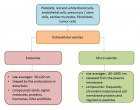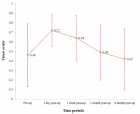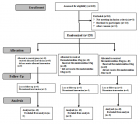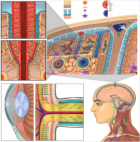Abstract
Research Article
Plant growth, Yield and Leaf Nutritional value of Jute (Corchorus olitorius L.) as Influenced by Banana Peel levels under Salt Stress conditions in Coastal region of Cameroon
Mathias Julien Hand*, Chimène Fanta Abib, Kingsley Mbi Tabi, Alphonse Ervé Nouck, Libert Brice Tonfack, Victor Désiré Taffouo and Emmanuel Youmbi
Published: 30 November, 2024 | Volume 8 - Issue 3 | Pages: 131-140
In the world, millions of hectares of cultivated land are affected by salt, making salinity a major constraint for plant production.
The effects of different levels of banana peel on growth, yield, and chemical changes of jute (Corchorus olitorius L.) under salt stress were examined herein. Response of jute to applications of different levels of banana peel (5, 10, and 15 t ha-1), as well as water irrigation salinity at 50, 100, and 200 mM NaCl were evaluated under greenhouse conditions.
The outcome uncovered that salinity caused significant reduction of plant growth and yield parameters, chlorophyll (at 21.6%), LRWC (at 18.9%), P (at 57.1%) and K (at 45.4%) content, while MDA content
(at 351.8%), Na (at 266%), soluble proteins (70.2%), total phenolic (at 23.4%) accumulation showed an increase from 0 to 200 mM NaCl without BP application. The banana peel treatments (at 15 t ha-1 under 200 mM NaCl) diminished significantly damaging effects caused by salinity via a reduction in the Na (at 28.4%), total soluble sugars (at 17.8%), total flavonoids (at 20.1%), which enhanced number of leaves per plant (37.1%), plant height (at 19.8%), leave yield (at 41.4%), LRWC (at 12.8%), Mg (at 24.2%) and reduced the MDA content (at 20%), presenting a favorable effect in reducing the oxidative stress that emerged from salt stress.
It could be concluded, that the application of 15 t ha-1 of BP was superior in promoting plant growth, yield, and nutritional quality than others under control and in the saline soils in this study. BP at 15 t ha-1 had a more reduced damage of salt stress effect on growth, yield, nutritional value, and use efficiency.
Read Full Article HTML DOI: 10.29328/journal.jpsp.1001145 Cite this Article Read Full Article PDF
Keywords:
Antioxidant; Banana peel; Osmolytes; Jute; Salinity
References
- Islam MS, Saito JA, Emdad EM, Ahmed B, Islam MM, Halim A, et al. Comparative genomics of two jute species and insight into fiber biogenesis. Nat Plants. 2017;3:1–7. Available from: https://www.nature.com/articles/nplants2016223
- Isuosuo CC, Akaneme FI, Abu NE. Nutritional evaluation of the seeds of Corchorus olitorius: a neglected and underutilized species in Nigeria. Pak J Nutr. 2019;18:692–703. Available from: https://doi.org/10.3923/pjn.2019.692.703
- Sanyaolu VT, Sanyaolu AAA, Fadele E. Spatial variation in heavy metal residue in Corchorus olitorius cultivated along a major highway in Ikorodu-Lagos, Nigeria. J Appl Sci Environ Manage. 2011;15:283–287. Available from: http://dx.doi.org/10.4314/jasem.v15i2.68511
- Lee YH, Choo C, Watawana MI, Jayawardena N, Waisundara VY. An appraisal of eighteen commonly consumed edible plants as functional food based on their antioxidant and starch hydrolase inhibitory activities. J Sci Food Agric. 2015;95(14):2956–2964. Available from: https://doi.org/10.1002/jsfa.7039
- Zakaria ZA, Somchit MN, Zaiton H, Jais AMM, Sulaiman MR, Farah WO, et al. The in vitro antibacterial activity of Corchorus olitorius extracts. Int J Pharmacol. 2006;2:213–215. Available from: https://www.cabidigitallibrary.org/doi/full/10.5555/20063081118
- Azuma K, Nakayama M, Koshioka M, Ippoushi K, Yamaguchi Y, Kohata K, et al. Phenolic antioxidants from the leaves of Corchorus olitorius L. J Agric Food Chem. 1999;47(10):3963–3966. Available from: https://doi.org/10.1021/jf990347p
- Abo KA, Fred-jaiyesimi AA, Jaiyesimi AE. Ethnobotanical studies of medicinal plants used in the management of diabetes mellitus in South Western Nigeria. J Ethnopharmacol. 2008;115(1):67–71. Available from: https://doi.org/10.1016/j.jep.2007.09.005
- Wang SY, Bunce JA, Maas JL. Elevated carbon dioxide increases contents of antioxidant compounds in field-grown strawberries. J Agric Food Chem. 2003;51(15):4315–4320. Available from: https://doi.org/10.1021/jf021172d
- Al Batran R, Al-bayaty F, Abdulla MA, Al-Obaidi MJ, Hajrezaei M, Hassandarvish P, et al. Gastroprotective effects of Corchorus olitorius leaf extract against ethanol-induced gastric mucosal hemorrhagic lesions in rats. J Gastroenterol Hepatol. 2013;28:1321–1329. Available from: https://doi.org/10.1111/jgh.12229
- Hussein S, Shaukat M, Ashraf M, Zhu C, Jin Q, Zhang J. Salinity stress in arid and semiarid climates: Effects and management in field crops. In: Climate Change and Agriculture. 2019;123–145. Available from: https://www.intechopen.com/chapters/68075
- Almodares A, Hadi MR, Dosti B. The effects of salt stress on growth parameters and carbohydrate contents in sweet sorghum. Res J Environ Sci. 2008;2(4):298–304. Available from: https://doi.org/10.3923/rjes.2008.298.304
- Mbarki S, Skalicky M, Talbi O, Chakraborty A, Hnilicka F, Hejnak V, et al. Performance of Medicago sativa grown in clay soil favored by compost or farmyard manure to mitigate salt stress. Agron. 2020;10(1):94. Available from: https://doi.org/10.3390/agronomy10010094
- Bidabadi SS, Dehghanipoodeh S, Wright GC. Vermicompost leachate reduces some negative effects of salt stress in pomegranate. Int J Recycling Org Waste Agric. 2017;6:255-263. Available from: https://doi.org/10.1007/s40093-017-0173-7
- Ahmed BO, Inoue M, Moritani S. Effect of saline water irrigation and manure application on the available water content, soil salinity, and growth of wheat. Agric Water Manag. 2010;97:165-170. Available from: http://dx.doi.org/10.1016/j.agwat.2009.09.001
- Aina OE, Amoo SO, Mugivhisa LL, Olowoyo JO. Effect of organic and inorganic sources of nutrients on the bioactive compounds and antioxidant activity of tomato. Appl Ecol Env Res. 2019;17:3681-3694. Available from: http://dx.doi.org/10.15666/aeer/1702_36813694
- Baddour AG, Rashwan E, El-Sharkawy TA. Effect of organic manure, antioxidant, and proline on corn (Zea mays L.) grown under saline conditions. Environ Bio Soil Sec. 2017;203–217. Available from: https://doi.org/10.21608/jenvbs.2018.2513.1021
- Kumar KPS, Bhowmik D, Duraivel S, Umadevi M. Traditional and medicinal uses of banana. J Pharmacogn Phytochem. 2012;1:51. Available from: https://www.phytojournal.com/vol1Issue3/Issue_sept_2012/9.1.pdf
- Hoagland DR, Arnon DI. The water culture method for growing plants without soil. University of California, College of Agriculture, Agricultural Experiment Station, Baltimore, USA. 1950. Available from: https://www.scirp.org/reference/referencespapers?referenceid=1850958
- Walkley A, Black IA. An examination of the Degtjareff method for determining soil organic matter and a proposed modification of the chromic acid titration method. Soil Sci. 1934;37:29-38. Available from: http://dx.doi.org/10.1097/00010694-193401000-00003
- Okalebo JR, Gathua WK, Woomer PL. Laboratory methods of soil and plant analysis: a working manual. Soil Biology and Fertility, Soil Science Society of East Africa, Kari, UNESCO-ROSTA Nairobi, Kenya. 1993;88. Available from: https://www.scirp.org/reference/referencespapers?referenceid=2505600
- Hand MJ, Nono GV, Taffouo VD, Youmbi E. Nutrient composition, antioxidant components, and ascorbic acid content response of pepper fruit (Capsicum annuum L.) cultivars grown under salt stress. Open Access Library J. 2021;8:e6830:1–20. Available from: http://dx.doi.org/10.4236/oalib.1106830
- Taleisnik E, Peyrano G, Arias C. Response of Chloris gayana cultivars to salinity. 1. Germination and early vegetative growth. Trop Grassl. 1997;31:232-240. Available from: https://www.tropicalgrasslands.info/public/journals/4/Historic/Tropical%20Grasslands%20Journal%20archive/PDFs/Vol_31_1997/Vol_31_03_97_pp232_240.pdf
- Metwally SA, Khalid KA, Abou-Leila BH. Effect of water regime on the growth, flower yield, essential oil, and proline contents of Calendula officinalis. Nusantara Biosci. 2013;5(2):65-69. Available from: https://doi.org/10.13057/nusbiosci/n050203
- Kumar N, Krishnamoorty V, Nalina L, Soorianathasundharam K. A new factor for estimating total leaf area in bananas. InfoMusa. 2002;11:42–43. Available from: https://eurekamag.com/research/003/623/003623277.php?srsltid=AfmBOopbO2KwWg5ehMmdW7mqKK71-CLvgSkiQxsyRoDazO3Dfvr87KvQ
- Lichtenthaler HK, Wellburn AR. Determinations of total carotenoids and chlorophylls a and b of leaf extracts in different solvents. Biochem Soc Trans. 1983;11:591–592. Available from: https://www.researchgate.net/publication/313724134_Determination_of_total_carotenoids_and_chlorophylls_a_and_b_of_leaf_in_different_solvents
- Dubois M, Gilles KA, Hamilton JK, Rebers PA, Smith F. Colorimetric method for determination of sugars and related substances. Anal Chem. 1956;28:350–356. Available from: https://doi.org/10.1021/ac60111a017
- Bradford MM. A rapid and sensitive method for the quantitation of microgram quantities of proteins utilizing the principle of protein-dye binding. Anal Biochem. 1976;72:248–254. Available from: https://doi.org/10.1006/abio.1976.9999
- Seckin B, Sekmen AH, Türkan S. An enhancing effect of exogenous mannitol on the antioxidant enzyme activities in roots of wheat under salt stress. J Plant Growth Regul. 2009;28:12–20. Available from: http://dx.doi.org/10.1007/s00344-008-9068-1
- Gossett DR, Millhollon EP, Lucas MC. Antioxidant response to NaCl stress in salt tolerant and salt-sensitive cultivars of cotton. Crop Sci. 1994;34:706–714. Available from: https://doi.org/10.2135/cropsci1994.0011183X003400030020x
- Gahler S, Otto K, Bohm V. Alterations of Vitamin C, total phenolics, and antioxidant capacity as affected by processing tomatoes to different products. J Agric Food Chem. 2003;51:7962–7968. Available from: https://doi.org/10.1021/jf034743q
- Marigo G. On a fractionation method and estimation of the phenolic compounds in plants. Analysis. 1973;2:106–110. Available from: https://pascal-francis.inist.fr/vibad/index.php?action=getRecordDetail&idt=PASCAL7332009482
- Chang CC, Yang MH, Wen HM, Chern JC. Estimation of total flavonoid content in propolis by two complementary colorimetric methods. J Food Drug Anal. 2002;10:178–182. Available from: https://doi.org/10.38212/2224-6614.2748
- Abreu CA. Comparison of analysis methods to assess the availability of metals in soils. Rev Bras Cienc Solo. 1995;19:463–468.
- Malavolta E, Vitti GC, Oliveira SA. Assessment of the nutritional status of plants: principles and applications. 2nd ed. Piracicaba, SP: POTAFOS; 1997. 319. Available from: https://www.scirp.org/reference/referencespapers?referenceid=2937675
- Pauwels JM, Van Ranst E, Verloo M, Mvondo ZA. Analysis methods of major plant elements. Pedology Laboratory Manual: Methods of Plants and Soil Analysis. AGCD, Brussels. 1992;28: Available from: https://www.scirp.org/reference/referencespapers?referenceid=2937676
- Hand MJ, Abib CF, Ousman S, Tabi KM, Oumarou B, Taffouo VD, et al. Influence of different rates of salinity on flowering, yield and fruit nutritional value of three okra [Abelmoschus esculentus (L.) Moench] cultivars in far North Region of Cameroon. Plant. 2024;12(3):66–75. Available from: https://doi.org/10.11648/j.plant.20241203.13
- Abou El-Magd MM, Zaki MF, Abou-Hussein SD. Effect of organic manure and different levels of saline irrigation water on growth, green yield, and chemical content of sweet fennel. Aust J Basic Appl Sci. 2008;2(1):90–98. Available from: https://www.ajbasweb.com/old/ajbas/2008/90-98.pdf
- Hand MJ, Nassourou M, Nono GV, Taffouo VD, Youmbi E. Organic and inorganic nutrient sources influenced growth, flowering, fruition, fruit relative water content, and yield of pepper (Capsicum annuum L.) cultivars under salinity in coastal region of Cameroon. Int J Agron Agric Res. 2021;18(5):33–51. Available from: https://www.innspub.net/wp-content/uploads/2022/06/IJAAR-V18-No5-p33-51.pdf
- Acosta-Motos JR, Ortuño MF, Bernal-Vicente A, Diaz-Vivancos P, Sanchez-Blanco MJ, Hernandez JA. Plant responses to salt stress: adaptive mechanisms. Agron. 2017;7(1):18. Available from: https://doi.org/10.3390/agronomy7010018
- Dineshkumar R, Subramanian J, Arumugam A, Rasheeq AA, Sampathkumar P. Exploring the microalgae biofertilizer effect on onion cultivation by field experiment. Waste Biomass Valori. 2018;1–11. Available from: https://link.springer.com/article/10.1007/s12649-018-0466-8
- Hand MJ, Nouck AE, Nassourou AM, Abib CF, Tonfack LB, Taffouo VD, et al. Influence of salt stress on growth, leaf pigmentation, ionic distribution, and metabolites accumulation of Talinum triangulare (Jacq.) Willd. leafy vegetables as affected by different cassava peel levels. J Adv Res Food Agric Environ Sci. 2022;8(9):1–10. Available from: https://doi.org/10.53555/nnfaes.v8i9.1419
- Zhu G, Chen Y, Ella ES, Ismail AM. Mechanisms associated with tiller suppression under stagnant flooding in rice. J Agron Crop Sci. 2019;205:235–247. Available from: https://doi.org/10.1111/jac.12316
- Henry EE, Sossa E, Noumavo AP, Amadji G, Baba-Moussa L, Gandonou CB. Ions and organic solutes as implicated in the ameliorative effect of the exogenous application of calcium on salt-stressed tomatoes (Lycopersicon esculentum Mill.) plants. Int J Plant Soil Sci. 2021;33(18):200–212. Available from: https://doi.org/10.9734/ijpss/2021/v33i1830590
- Loko B, Montcho KDH, Agbossékpé F, Mensah ACG, Assogba-Komlan F, Lutts S, et al. Response of African basil (Ocimum gratissimum L.) to salt stress under tropical conditions in the Republic of Benin: growth, ions, and organic solutes accumulation. Int J Plant Soil Sci. 2022;34(17):47–60. Available from: https://doi.org/10.9734/ijpss/2022/v34i1731035
- Shahid MA, Sarkhosh A, Khan N, Balal RM, Ali S, Rossi L, et al. Insights into the physiological and biochemical impacts of salt stress on plant growth and development. Agron. 2020;10:938. Available from: https://doi.org/10.3390/agronomy10070938
- Ahanger MA, Agarwal RM. Salinity stress-induced alterations in antioxidant metabolism and nitrogen assimilation in wheat (Triticum aestivum L) as influenced by potassium supplementation. Plant Physiol Biochem. 2017;115:449–460. Available from: https://doi.org/10.1016/j.plaphy.2017.04.017
- Singh R, Upadhyay AK, Singh DP. Regulation of oxidative stress and mineral nutrient status by selenium in arsenic-treated crop plant Oryza sativa. Ecotoxicol Environ Saf. 2018;148:105–113. Available from: https://www.ncbi.nlm.nih.gov/pubmed/29035752
- Anjum NA, Gill R, Kaushik M, Hasanuzzaman M, Pereira E, Ahmad I, et al. ATP-sulfurylase, sulfur compounds, and plant stress tolerance. Front Plant Sci. 2015;6:210. Available from: https://doi.org/10.3389/fpls.2015.00210
- Commisso M, Toffali K, Strazzer P, Stocchero M, Ceoldo S, Baldan B, et al. Impact of phenylpropanoid compounds on heat stress tolerance in carrot cell cultures. Front Plant Sci. 2016;7:1439. Available from: https://doi.org/10.3389/fpls.2016.01439
- Jabeen N, Ahmad R. Growth response and nitrogen metabolism of sunflower (Helianthus annuus L.) to vermicompost and biogas slurry under salinity stress. J Plant Nutr. 2017;40(1):104–114. Available from: http://dx.doi.org/10.1080/01904167.2016.1201495
- Gouveitcha MBG, Kpinkoun JK, Mensah ACG, Gandonou GCB. Salinity resistance strategy of okra (Abelmoschus esculentus L. Moench) cultivars produced in Benin Republic. Int J Plant Physiol Biochem. 2021;13:19–29. Available from: https://doi.org/10.5897/IJPPB2021.0308
- Loko B, Henry EEY, Prodjinoto H, Gouveitcha MBG, Gandonou CB. Response of tossa jute (Corchorus olitorius L.) salt-stressed plants to external application of calcium and potassium. Int J Plant Physiol Biochem. 2022;14(1):1–12. Available from: https://doi.org/10.5897/IJPPB2022.0316
- Burhan AK, AL-Taey DK. Effect of potassium humate, humic acid, and compost of rice wastes in the growth and yield of two cultivars of dill under salt stress conditions. Adv Nat Appl Sci. 2018;12(11):1–6. Available from: https://www.aensiweb.net/AENSIWEB/anas/anas/2018/November/1-6(1).pdf
Figures:

Figure 1

Figure 2

Figure 3
Similar Articles
-
Physiological impact of Zinc nanoparticle on germination of rice (Oryza sativa L) seedUpadhyaya H*,Roy H,Shome S,Tewari S,Bhattacharya MK,Panda SK. Physiological impact of Zinc nanoparticle on germination of rice (Oryza sativa L) seed . . 2017 doi: 10.29328/journal.jpsp.1001008; 1: 062-070
-
Bacillus amyloliquefaciens as a plant growth promoting bacteria with the interaction with of grass salt Distichlis palmeri (Vasey) under field conditions, in desert of Sonora, MexicoRueda Puente Edgar O*,Ruiz Alvarado Cristina,Jesús Borboa Flores,Victor Cardenas Salazar,Soto Ortiz Roberto,Lourdes Díaz Cervantes. Bacillus amyloliquefaciens as a plant growth promoting bacteria with the interaction with of grass salt Distichlis palmeri (Vasey) under field conditions, in desert of Sonora, Mexico. . 2018 doi: 10.29328/journal.jpsp.1001021; 2: 059-067
-
Ion transporters and their molecular regulation mechanism in plantsFaiçal Brini*,Walid Saibi. Ion transporters and their molecular regulation mechanism in plants. . 2021 doi: 10.29328/journal.jpsp.1001058; 5: 028-043
-
Chemical composition of olive stems essential oil from EthiopiaMelese Damtew Asfaw*. Chemical composition of olive stems essential oil from Ethiopia. . 2022 doi: 10.29328/journal.jpsp.1001075; 6: 057-061
-
Snapshot of the Involvement of Glutathione in Plant-Pathogen InteractionsAparupa Bose Mazumdar Ghosh, Sharmila Chattopadhyay*. Snapshot of the Involvement of Glutathione in Plant-Pathogen Interactions. . 2023 doi: 10.29328/journal.jpsp.1001103; 7: 039-041
-
Determination of the Potential for use of Plant Essential Oils as a Fungicide Against Fusarium Oxysporum (OG10)Elif Tan*, Ebru Gezgincioğlu, Özlem Gülmez and Özlem Barış. Determination of the Potential for use of Plant Essential Oils as a Fungicide Against Fusarium Oxysporum (OG10). . 2023 doi: 10.29328/journal.jpsp.1001114; 7: 107-112
-
GS-MS Profile, Total Flavonoid and Phenolic Contents and Antioxidant Capacity of Leaves of Vitelleria paradoxa c.f. GaertnTheresa Ibibia Edewor*, Amuda Mutiu Olasunkanmi, Stephen Oluwagbemiga Owa. GS-MS Profile, Total Flavonoid and Phenolic Contents and Antioxidant Capacity of Leaves of Vitelleria paradoxa c.f. Gaertn. . 2024 doi: 10.29328/journal.jpsp.1001131; 8: 043-047
-
Plant growth, Yield and Leaf Nutritional value of Jute (Corchorus olitorius L.) as Influenced by Banana Peel levels under Salt Stress conditions in Coastal region of CameroonMathias Julien Hand*,Chimène Fanta Abib,Kingsley Mbi Tabi,Alphonse Ervé Nouck,Libert Brice Tonfack,Victor Désiré Taffouo,Emmanuel Youmbi. Plant growth, Yield and Leaf Nutritional value of Jute (Corchorus olitorius L.) as Influenced by Banana Peel levels under Salt Stress conditions in Coastal region of Cameroon. . 2024 doi: 10.29328/journal.jpsp.1001145; 8: 131-140
Recently Viewed
-
Pneumothorax as Complication of CT Guided Lung Biopsy: Frequency, Severity and Assessment of Risk FactorsGaurav Raj*,Neha Kumari,Neha Singh,Kaustubh Gupta,Anurag Gupta,Pradyuman Singh,Hemant Gupta. Pneumothorax as Complication of CT Guided Lung Biopsy: Frequency, Severity and Assessment of Risk Factors. J Radiol Oncol. 2025: doi: 10.29328/journal.jro.1001075; 9: 012-016
-
The Police Power of the National Health Surveillance Agency – ANVISADimas Augusto da Silva*,Rafaela Marinho da Silva. The Police Power of the National Health Surveillance Agency – ANVISA. Arch Cancer Sci Ther. 2024: doi: 10.29328/journal.acst.1001046; 8: 063-076
-
A Comparative Study of Serum Sodium and Potassium Levels across the Three Trimesters of PregnancyOtoikhila OC and Seriki SA*. A Comparative Study of Serum Sodium and Potassium Levels across the Three Trimesters of Pregnancy. Clin J Obstet Gynecol. 2023: doi: 10.29328/journal.cjog.1001137; 6: 108-116
-
Chaos to Cosmos: Quantum Whispers and the Cosmic GenesisOwais Farooq*,Romana Zahoor*. Chaos to Cosmos: Quantum Whispers and the Cosmic Genesis. Int J Phys Res Appl. 2025: doi: 10.29328/journal.ijpra.1001107; 8: 017-023
-
Phytochemical Compounds and the Antifungal Activity of Centaurium pulchellum Ethanol Extracts in IraqNoor Jawad Khadhum, Neepal Imtair Al-Garaawi*, Antethar Jabbar Al-Edani. Phytochemical Compounds and the Antifungal Activity of Centaurium pulchellum Ethanol Extracts in Iraq. J Plant Sci Phytopathol. 2024: doi: 10.29328/journal.jpsp.1001137; 8: 079-083
Most Viewed
-
Evaluation of Biostimulants Based on Recovered Protein Hydrolysates from Animal By-products as Plant Growth EnhancersH Pérez-Aguilar*, M Lacruz-Asaro, F Arán-Ais. Evaluation of Biostimulants Based on Recovered Protein Hydrolysates from Animal By-products as Plant Growth Enhancers. J Plant Sci Phytopathol. 2023 doi: 10.29328/journal.jpsp.1001104; 7: 042-047
-
Sinonasal Myxoma Extending into the Orbit in a 4-Year Old: A Case PresentationJulian A Purrinos*, Ramzi Younis. Sinonasal Myxoma Extending into the Orbit in a 4-Year Old: A Case Presentation. Arch Case Rep. 2024 doi: 10.29328/journal.acr.1001099; 8: 075-077
-
Feasibility study of magnetic sensing for detecting single-neuron action potentialsDenis Tonini,Kai Wu,Renata Saha,Jian-Ping Wang*. Feasibility study of magnetic sensing for detecting single-neuron action potentials. Ann Biomed Sci Eng. 2022 doi: 10.29328/journal.abse.1001018; 6: 019-029
-
Pediatric Dysgerminoma: Unveiling a Rare Ovarian TumorFaten Limaiem*, Khalil Saffar, Ahmed Halouani. Pediatric Dysgerminoma: Unveiling a Rare Ovarian Tumor. Arch Case Rep. 2024 doi: 10.29328/journal.acr.1001087; 8: 010-013
-
Physical activity can change the physiological and psychological circumstances during COVID-19 pandemic: A narrative reviewKhashayar Maroufi*. Physical activity can change the physiological and psychological circumstances during COVID-19 pandemic: A narrative review. J Sports Med Ther. 2021 doi: 10.29328/journal.jsmt.1001051; 6: 001-007

HSPI: We're glad you're here. Please click "create a new Query" if you are a new visitor to our website and need further information from us.
If you are already a member of our network and need to keep track of any developments regarding a question you have already submitted, click "take me to my Query."
























































































































































